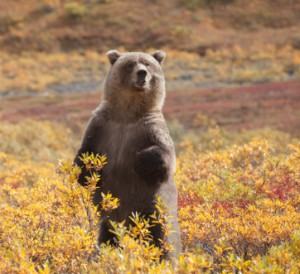One of the main tenets of environmentally friendly camping is to avoid disturbing local wildlife. While the occasional sighting is certainly cool and not often a problem, displacing native animals is considered irresponsible by most outdoor enthusiasts. To be fair, most don’t intend to interrupt the life patterns of animals when they camp. But by ignoring signs of their presence and moving in on them, they unintentionally scare animals out of their natural homes. Before setting up camp, there are a few signs you should look for to ensure you’re not encroaching on their territory.
 1. Natural paths. Though natural paths and clearings are often ideal for setting up camp, they often happen to be spots where wildlife congregates. If a path looks like it’s been created by animals and not humans, it’s best to move on to the next potential campsite. Evidence of animal created paths includes hoof or foot tracks, mangled brush, and chewed-on material along the trail.
1. Natural paths. Though natural paths and clearings are often ideal for setting up camp, they often happen to be spots where wildlife congregates. If a path looks like it’s been created by animals and not humans, it’s best to move on to the next potential campsite. Evidence of animal created paths includes hoof or foot tracks, mangled brush, and chewed-on material along the trail.
2. Bedding areas. Like humans, wildlife such as deer, raccoons, foxes, and other mammals prefer to have some sort of shelter from the elements. In much of the country, this includes areas with low lying tree branches overhanging natural clearings. These trees serve to block precipitation and protect animals from harsh winds. Softwood trees like pines and cedars often provide this kind of coverage, so it is recommended that you scan more closely for evidence of habitation before setting up camp under them.
3. Burrows. Smaller mammals typically dig out burrows in soil or organic material such as tree trunks. They’re usually pretty easy to spot, as an entrance hole is often clearly visible. If you’re setting up camp next to any large trees or dead logs, be sure to check for these entry and exit points. Not only might you disturb a den of animals, you might also be putting your own camping items at risk. Den-digging animals such as foxes and raccoons have no qualms about digging into your camp’s food while you’re fast asleep.
4. Watering holes. If you plan on camping next to a creek or river, keep an eye out for animal tracks and droppings. Blocking access to watering holes that wildlife frequents isn’t exactly healthy for the local environment. There is typically a wealth of other good camping spots to find in natural bank-side clearings as a result of past flooding.
Campers are one of the most environmentally conscious groups there are. In order to fulfill that reputation and do your part, avoiding spots where wildlife congregates is vital. Using the common signs above, you’ll be able to enjoy the outdoors without ruining its pristine state.


thanks for telling me what to look for when I go camping outside, I don’t want to run into any crazed animals. thank you very much…
I just found this blog post on the internet and found it very informative and useful for my upcoming camping trip out West. Thanks for the info!
There is enough room for all of us to co-habitat respectfully and enjoy the beauty!